P. L. Travers
Appearance

Pamela Lyndon Travers (August 9 1899 – April 23 1996) was a British author, born Helen Lyndon Goff in Maryborough, Queensland, Australia, best known as the creator of the "Mary Poppins" series of stories.
- See also
- Mary Poppins (1964 film)
Quotes
[edit]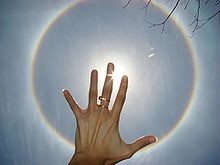
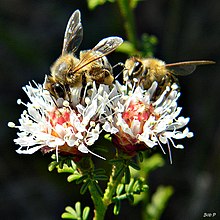

- Mary Poppins is both a joy and a curse to me as a writer ... As a writer, you can feel awfully imprisoned, because people, having had so much of one thing, want you always to go on doing more of the same.
- Quoted in Current Biography Yearbook 1996, p. 580.
- There are worlds beyond worlds and times beyond times, all of them true, all of them real, and all of them (as children know) penetrating each other.
- From "Personal View," by P. L. Travers, in The Sunday Times (London), issue 8575 (11 December 1988).
- When I was a child, love to me was what the sea is to a fish: something you swim in while you are going about the important affairs of life.
- From "I Never Wrote for Children," by P. L. Travers, in The New York Times Magazine (2 July 1978).
- The silky hush of intimate things, fragrant with my fragrance, steal softly down, so loth to rob me of my last dear concealment.
- From a poem (c. 1920) in the Australian publication The Triad, as quoted in Out of the Sky She Came: The Life of P.L. Travers, Creator of Mary Poppins (1999) by Valerie Lawson, ISBN 0733610722 [U.S. and U.K. title: Mary Poppins, She Wrote : The Life of P. L. Travers (2006) ISBN 0743298160]
- It is clear from Gurdjieff's writings that hypnotism, mesmerism and various arcane methods of expanding consciousness must have played a large part in the studies of the Seekers of Truth. None of these processes, however, is to be thought of as having any bearing on what is called Black Magic, which, according to Gurdjieff, "has always one definite characteristic. It is the tendency to use people for some, even the best of aims, without their knowledge and understanding, either by producing in them faith and infatuation or by acting upon them through fear. There is, in fact, neither red, green nor yellow magic. There is "doing." Only "doing" is magic." Properly to realise the scale of what Gurdjieff meant by magic, one has to remember his continually repeated aphorism, "Only he who can be can do," and its corollary that, lacking this fundamental verb, nothing is "done," things simply "happen."
- Could it be ... that the hero is one who is willing to set out, take the first step, shoulder something? Perhaps the hero is one who puts his foot upon a path not knowing what he may expect from life but in some way feeling in his bones that life expects something of him.
- The World of the Hero (1976)
- A writer is, after all, only half his book. The other half is the reader and from the reader the writer learns.
- As quoted in The New York Times (2 July 1978)
- A great friend of mine at the beginning of our friendship (he was himself a poet) said to me very defiantly, "I have to tell you that I loathe children's books." And I said to him, "Well, won't you just read this just for my sake?" And he said grumpily, "Oh, very well, send it to me." I did, and I got a letter back saying: "Why didn't you tell me? Mary Poppins with her cool green core of sex has me enthralled forever."
- “Myth, Symbol, and Tradition” was the phrase I originally wrote at the top of the page, for editors like large, cloudy titles. Then I looked at what I had written and, wordlessly, the words reproached me. I hope I had the grace to blush at my own presumption and their portentousness. How could I, if I lived for a thousand years, attempt to cover more than a hectare of that enormous landscape?
So, I let out the air, in a manner of speaking, dwindled to my appropriate size, and gave myself over to that process which, for lack of a more erudite term, I have coined the phrase “Thinking is linking.” I thought of Kerenyi — “Mythology occupies a higher position in the bios, the Existence, of a people in which it is still alive than poetry, storytelling or any other art.” And of Malinowski — “Myth is not merely a story told, but a reality lived.” And, along with those, the word “Pollen,” the most pervasive substance in the world, kept knocking at my ear. Or rather, not knocking, but humming. What hums? What buzzes? What travels the world? Suddenly I found what I sought. “What the bee knows,” I told myself. “That is what I’m after.”
But even as I patted my back, I found myself cursing, and not for the first time, the artful trickiness of words, their capriciousness, their lack of conscience. Betray them and they will betray you. Be true to them and, without compunction, they will also betray you, foxily turning all the tables, thumbing syntactical noses. For — note bene! — if you speak or write about What The Bee Knows, what the listener, or the reader, will get — indeed, cannot help but get — is Myth, Symbol, and Tradition! You see the paradox? The words, by their very perfidy — which is also their honorable intention — have brought us to where we need to be. For, to stand in the presence of paradox, to be spiked on the horns of dilemma, between what is small and what is great, microcosm and macrocosm, or, if you like, the two ends of the stick, is the only posture we can assume in front of this ancient knowledge — one could even say everlasting knowledge.- "What the Bee Knows" in Parabola : The Magazine of Myth and Tradition, Vol. VI, No. 1 (February 1981); later published in What the Bee Knows : Reflections on Myth, Symbol, and Story (1989)
- The Sphinx, the Pyramids, the stone temples are, all of them, ultimately, as flimsy as London Bridge; our cities but tents set up in the cosmos. We pass. But what the bee knows, the wisdom that sustains our passing life — however much we deny or ignore it — that for ever remains.
- What the Bee Knows : Reflections on Myth, Symbol, and Story (1989)
- The Irish, as a race, have the oral tradition in their blood. A direct question to them is an anathema, but in other cases, a mere syllable of a hero's name will elicit whole chapters of stories.
- As quoted in No Word for Time: The Way of the Algonquin People (2001) by Evan T. Pritchard
- You do not chop off a section of your imaginative substance and make a book specifically for children, for — if you are honest — you have no idea where childhood ends and maturity begins. It is all endless and all one.
- As quoted in Sticks and Stones : The Troublesome Success of Children's Literature from Slovenly Peter to Harry Potter (2002) by Jack Zipes
- You can ask me anything you like about my work, but I'll never talk about myself.
- As quoted by Valerie Lawson, in an interview: "The Mystic Life of P.L. Travers" (7 May 2003)
- For me there are no answers, only questions, and I am grateful that the questions go on and on. I don't look for an answer, because I don't think there is one. I'm very glad to be the bearer of a question.
Mary Poppins (1934)
[edit]
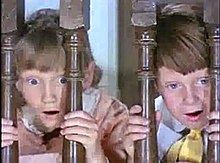


- If you want to find Cherry-Tree Lane all you have to do is ask the Policeman at the cross-roads. He will push his helmet slightly to one side, scratch his head thoughtfully, and then he will point his huge white-gloved finger and say: "First to your right, second to your left, sharp right again, and you're there. Good-morning."
And sure enough, if you follow his directions exactly, you will be there — right in the middle of Cherry-Tree Lane, where the houses run down one side and the Park runs down the other and the cherry-trees go dancing right down the middle.
If you are looking for Number Seventeen — and it is more than likely that you will be, for this book is all about that particular house — you will very soon find it.- Ch. 1 "East-Wind" (opening lines)
- Jane and Michael sat at the window watching for Mr. Banks to come home, and listening to the sound of the East Wind blowing through the naked branches of the cherry-trees in the Lane. The trees themselves, turning and bending in the half light, looked as though they had gone mad and were dancing their roots out of the ground.
"There he is!" said Michael, pointing suddenly to a shape that banged heavily against the gate. Jane peered through the gathering darkness.
"That's not Daddy," she said. "It's somebody else."
Then the shape, tossed and bent under the wind, lifted the latch of the gate, and they could see that it belonged to a woman, who was holding her hat on with one hand and carrying a bag in the other. As they watched, Jane and Michael saw a curious thing happen. As soon as the shape was inside the gate the wind seemed to catch her up into the air and fling her at the house. It was as though it had flung her first at the gate, waited for her to open it, and then had lifted and thrown her, bag and all, at the front door. The watching children heard a terrific bang, and as she landed the whole house shook.
"How funny! I've never seen that happen before," said Michael.- Ch. 1 "East-Wind"
- Presently they saw their Mother coming out of the drawing-room with a visitor following her. Jane and Michael could see that the newcomer had shiny black hair — "Rather like a wooden Dutch doll," whispered Jane. And that she was thin, with large feet and hands, and small, rather peering blue-eyes.
"You'll find that they are very nice children," Mrs. Banks was saying.
Michael's elbow gave a sharp dig at Jane's ribs.
"And that they give no trouble at all," continued Mrs. Banks uncertainly, as if she herself didn't really believe what she was saying. They heard the visitor sniff as though she didn't either.
"Now, about reference —" Mrs. Banks went on.
"Oh, I make it a rule never to give references," said the other firmly.- Ch. 1 "East-Wind"
- Mrs. Banks did not notice what was happening behind her, but Jane and Michael, watching from the top landing, had an excellent view of the extraordinary thing the visitor now did.
Certainly she followed Mrs. Banks upstairs, but not in the usual way. With her large bag in her hands she slid gracefully up the banisters, and arrived at the landing at the same time as Mrs. Banks. Such a thing, Jane and Michael knew, had never been done before. Down, of course, for they had often done it themselves. But up — never! They gazed curiously at the strange new visitor.- Ch. 1 "East-Wind"
- I always thought dancing improper; but it can't be since I myself am dancing.
- The Red Cow in Ch. 5 "The Dancing Cow"
- What I want to know is this: Are the stars gold paper or is the gold paper stars?
- Jane in Ch. 8 "Mrs. Corry"
- Tonight the small are free from the great and the great protect the small.
- Hamadryad, the King Cobra in Ch. 10 "Full-Moon"
- It may be that to eat and be eaten are the same thing in the end. My wisdom tells me that this is probably so. We are all made of the same stuff, remember, we of the Jungle, you of the City. The same substance composes us — the tree overhead, the stone beneath us, the bird, the beast, the star — we are all one, all moving to the same end. Remember that when you no longer remember me, my child.
- Hamadryad, the King Cobra in Ch. 10 "Full-Moon"
- "Bird and beast and stone and star — we are all one, all one —" murmured the Hamadryad, softly folding his hood about him as he himself swayed between the children.
"Child and serpent, star and stone — all one."- Ch. 10 "Full-Moon"
Mary Poppins Opens the Door (1943)
[edit]

- The Fifth of November is Guy Fawkes' Day in England. In peacetime it is celebrated with bonfires on the greens, fireworks in the parks and the carrying of "guys" through the streets. "Guys" are stuffed, straw figures of unpopular persons; and after they have been shown to everybody they are burnt in the bonfires amid great acclamation. The children black their faces and put on comical clothes, and go about begging for a Penny for the Guy. Only the very meanest people refuse to give pennies and these are always visited by Extreme Bad Luck.
The Original Guy Fawkes was one of the men who took part in the Gunpowder Plot. This was a conspiracy for blowing up King James I and the Houses of Parliament on November 5th, 1605. The plot was discovered, however, before any damage was done. The only result was that King James and his Parliament went on living but Guy Fawkes, poor man, did not. He was executed with the other conspirators. Nevertheless, it is Guy Fawkes who is remembered today and King James who is forgotten. For since that time, the Fifth of November in England, like the Fourth of July in America, has been devoted to Fireworks. From 1605 till 1939 every village green in the shires had a bonfire on Guy Fawkes' Day.- NOTE (on Guy Fawkes' Day)
- In the village where I live, in Sussex, we made our bonfire in the Vicarage paddock and every year, as soon as it was lit, the Vicar's cow would begin to dance. She danced while the flames rose up to the sky, she danced till the ashes were black and cold. And the next morning — it was always the same — the Vicar would have no milk for his breakfast. It is strange to think of a simple cow rejoicing at the saving of Parliament so many years ago.
- NOTE
- Since 1939, however, there have been no bonfires on the village greens. No fireworks gleam in the blackened parks and the streets are dark and silent. But this darkness will not last forever. There will some day come a Fifth of November — or another date, it doesn't matter — when fires will burn in a chain of brightness from Land's End to John O' Groats. The children will dance and leap about them as they did in the times before. They will take each other by the hand and watch the rockets breaking, and afterwards they will go home singing to the houses full of light...
- NOTE (on Guy Fawkes' Day, during World War II)
- Mary Poppins herself had flown away, but the gifts she had brought would remain for always..
- Ch. 8 "The Other Door"
- We'll never forget you, Mary Poppins!
- Ch. 8 "The Other Door"
The Paris Review interview (1982)
[edit]- Interviewed by Edwina Burness and Jerry Griswold, in "P. L. Travers, The Art of Fiction No. 63" in The Paris Review No. 86 (Winter 1982)

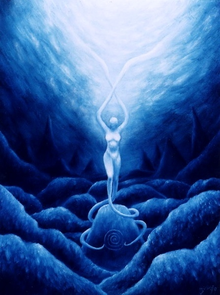


- I’ve always been interested in the Mother Goddess. Not long ago, a young person, whom I don’t know very well, sent a message to a mutual friend that said: “I’m an addict of Mary Poppins, and I want you to ask P. L. Travers if Mary Poppins is not really the Mother Goddess.” So, I sent back a message: “Well, I’ve only recently come to see that. She is either the Mother Goddess or one of her creatures — that is, if we’re going to look for mythological or fairy-tale origins of Mary Poppins.”
I’ve spent years thinking about it because the questions I’ve been asked, very perceptive questions by readers, have led me to examine what I wrote. The book was entirely spontaneous and not invented, not thought out. I never said, “Well, I’ll write a story about Mother Goddess and call it Mary Poppins.” It didn’t happen like that. I cannot summon up inspiration; I myself am summoned.
Once, when I was in the United States, I went to see a psychologist. It was during the war when I was feeling very cut off. I thought, Well, these people in psychology always want to see the kinds of things you’ve done, so I took as many of my books as were then written. I went and met the man, and he gave me another appointment. And at the next appointment the books were handed back to me with the words: "You know, you don’t really need me. All you need to do is read your own books."
That was so interesting to me. I began to see, thinking about it, that people who write spontaneously as I do, not with invention, never really read their own books to learn from them. And I set myself to reading them. Every now and then I found myself saying, "But this is true. How did she know?" And then I realized that she is me. Now I can say much more about Mary Poppins because what was known to me in my blood and instincts has now come up to the surface in my head.
- It is only through the ordinary that the extraordinary can make itself perceived.
- I think if she comes from anywhere that has a name, it is out of myth. And myth has been my study and joy ever since — oh, the age, I would think . . . of three. I’ve studied it all my life. No culture can satisfactorily move along its forward course without its myths, which are its teachings, its fundamental dealing with the truth of things, and the one reality that underlies everything.
- She doesn’t hold back anything from them. When they beg her not to depart, she reminds them that nothing lasts forever. She’s as truthful as the nursery rhymes. Remember that all the King’s horses and all the King’s men couldn’t put Humpty-Dumpty together again. There’s such a tremendous truth in that. It goes into children in some part of them that they don’t know, and indeed perhaps we don’t know. But eventually they realize — and that’s the great truth.
- My Zen master, because I’ve studied Zen for a long time, told me that every one (and all the stories weren’t written then) of the Mary Poppins stories is in essence a Zen story. And someone else, who is a bit of a Don Juan, told me that every one of the stories is a moment of tremendous sexual passion, because it begins with such tension and then it is reconciled and resolved in a way that is gloriously sensual. … A great friend of mine at the beginning of our friendship (he was himself a poet) said to me very defiantly, “I have to tell you that I loathe children’s books.” And I said to him, “Well, won’t you just read this just for my sake?” And he said grumpily, “Oh, very well, send it to me.” I did, and I got a letter back saying: “Why didn’t you tell me? Mary Poppins with her cool green core of sex has me enthralled forever.”
- Friend Monkey is really my favorite of all my books because the Hindu myth on which it is based is my favorite — the myth of the Monkey Lord who loved so much that he created chaos wherever he went. … when you read the Ramayana you’ll come across the story of Hanuman on which I built my version of that very old myth.
I love Friend Monkey. I love the story of Hanuman. For many years, it remained in my very blood because he’s someone who loves too much and can’t help it. I don’t know where I first heard of him, but the story remained with me and I knew it would come out of me somehow or other. But I didn’t know what shape it would take.
- I never wrote my books especially for children. … When I sat down to write Mary Poppins or any of the other books, I did not know children would read them. I’m sure there must be a field of “children’s literature” — I hear about it so often — but sometimes I wonder if it isn’t a label created by publishers and booksellers who also have the impossible presumption to put on books such notes as “from five to seven” or “from nine to twelve.” How can they know when a book will appeal to such and such an age?
If you look at other so-called children’s authors, you’ll see they never wrote directly for children. Though Lewis Carroll dedicated his book to Alice, I feel it was an afterthought once the whole was already committed to paper. Beatrix Potter declared, “I write to please myself!” And I think the same can be said of Milne or Tolkien or Laura Ingalls Wilder.
I certainly had no specific child in mind when I wrote Mary Poppins. How could I? If I were writing for the Japanese child who reads it in a land without staircases, how could I have written of a nanny who slides up the banister? If I were writing for the African child who reads the book in Swahili, how could I have written of umbrellas for a child who has never seen or used one?
But I suppose if there is something in my books that appeals to children, it is the result of my not having to go back to my childhood; I can, as it were, turn aside and consult it (James Joyce once wrote, “My childhood bends beside me”). If we’re completely honest, not sentimental or nostalgic, we have no idea where childhood ends and maturity begins. It is one unending thread, not a life chopped up into sections out of touch with one another.
Once, when Maurice Sendak was being interviewed on television a little after the success of Where the Wild Things Are , he was asked the usual questions: Do you have children? Do you like children? After a pause, he said with simple dignity: “I was a child.” That says it all.
- I make a point of writing, if only a little, every day, as a kind of discipline so that it is not a whim but a piece of work.
- I read myths and fairy tales and books about them a great deal now, but I very seldom read novels. I find modern novels bore me. I can read Tolstoy and the Russians, but mostly I read comparative mythology and comparative religion. I need matter to carry with me.
- When I write it’s more a process of listening. I don’t pretend that there is some spirit standing beside me that tells me things. More and more I’ve become convinced that the great treasure to possess is the unknown. I’m going to write, I hope, a lot about that. It’s with my unknowing that I come to the myths. If I came to them knowing, I would have nothing to learn. But I bring my unknowing, which is a tangible thing, a clear space, something that’s been made room for out of the muddle of ordinary psychic stuff, an empty space.
- You know C. S. Lewis, whom I greatly admire, said there’s no such thing as creative writing. I’ve always agreed with that and always refuse to teach it when given the opportunity. He said there is, in fact, only one Creator and we mix. That’s our function, to mix the elements He has given us. See how wonderfully anonymous that leaves us? You can’t say, “I did this; this gross matrix of flesh and blood and sinews and nerves did this.” What nonsense! I’m given these things to make a pattern out of. Something gave it to me.
I’ve always loved the idea of the craftsman, the anonymous man. For instance, I’ve always wanted my books to be called the work of Anon, because Anon is my favorite literary character. If you look through an anthology of poems that go from the far past into the present time, you’ll see that all the poems signed “Anon” have a very specific flavor that is one flavor all the way through the centuries. I think, perhaps arrogantly, of myself as “Anon.” I would like to think that Mary Poppins and the other books could be called back to make that change. But I suppose it’s too late for that.
Myth, Symbol, and Meaning in Mary Poppins (2007)
[edit]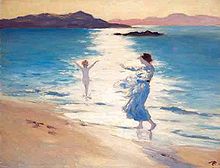
- Quotes of Travers from Myth, Symbol, and Meaning in Mary Poppins: The Governess as Provocateur (2007) by Giorgia Grilli
- These men — Yeats, James Stephens, and the rest — had aristocratic minds. For them, the world was not fragmented. An idea did not suddenly grow … all alone and separate. For them, all things had long family trees. They saw nothing shameful or silly in myths and fairy stories, nor did they shovel them out of sight and some cupboard marked "Only For Children." They were always willing to concede that there was more things in heaven and earth than philosophy dreamed of. They allowed for the unknown. And, as you can imagine, I took great heart from this. It was Æ who showed me how to look and learn from one's own writing. "Popkins" he said once — he always called her just plain Popkins, whether deliberately mistaking the name or not I never knew. His humor was always subtle — "Popkins had she lived in another age, in the old times to which she certainly belongs, she would undoubtedly have had long golden tresses, a wreath of flowers in one hand, and perhaps a spear in the other. Her eyes would have been like the sea, her nose comely, and on her feet winged sandals. But, this age being the Kali Yuga, as the Indus call it — in our terms, the Iron Age — she comes in habiliments suited to it."
- Ch. 2, p. 38
- The true fairytales … come straight out of myth; they are, as it were, minuscule reaffirmation of myths, or perhaps the myth made accessible to the local folky mind. One might say that fairytales are the myths falling into time and locality … is the same stuff, all the essentials are there, it is small, but perfect. Not minimized, not to be made digestible for children.
- Ch. 2, p. 39
Quotes about Travers
[edit]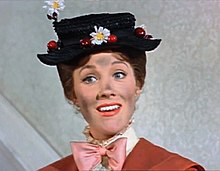


- Mary Poppins arrives with the wind, and intervenes in the lives of ordinary humans, making magic, but never admitting that it has taken place. She understands the language of animals and birds, and between her visits to mortals returns to some secret source. Although the Poppins books have much in common with other works of children's literature — all the way back to the early 19th century and ETA Hoffmann's inspiration of making toys come alive — Travers was adamant that she didn't write specifically for children, and that there was no such thing as children's books. Poppins, she said, "had come up of the same well of nothingness as the poetry, myths and legends that had absorbed me all my writing life." This was something else that connected Travers to Disney, who maintained that his films were not directed at children, but at the innocence within us all.
- Throughout their children's novels, Lewis and Travers bring together heterogeneous collections of characters from all orders of being — humanity, mythology (Greek, Norse, Christian), the animal world (both talking and nontalking beasts), and other fictional sources (for example, nursery rhyme and fairytale figures) — and have them mingle in festival-like gatherings reminiscent of medieval carnival celebrations. ... the interaction among these disparate characters often results in the suspension of hierarchical barriers...
- Mary Poppins advocates the kind of family life that Walt Disney had spent his career both chronicling and helping to foster on a national level: father at work, mother at home, children flourishing. It is tempting to imagine that in Travers he found a like-minded person, someone who embodied the virtues of conformity and traditionalism. Nothing could be further from the truth. Travers was a woman who never married, wore trousers when she felt like it, had a transformative and emotionally charged relationship with an older married man, and entered into a long-term live-in relationship with another woman. As she approached forty, she decided that she wanted a child. After a bizarre incident in which she attempted to adopt the seventeen-year-old girl who cleaned her house, she travelled to Ireland and adopted an infant, one of a pair of twins, and raised him as a single mother Her reverence for the delights of family life was perhaps as intense as Disney's, but her opinion about the shape such a life might assume was far more nuanced.
Children's authors are not known for their happy childhoods, and Helen Goff — the little girl who at twenty-one changed her name to Pamela Travers and never looked back — endured one that was almost archetypal in its sadness and its privations. She was born in Australia in 1899, the eldest daughter in a household of girls. Her father, Travers Goff, was a bank manager and a drinker, and he died when she was seven.... Her mother, Margaret, who was pretty and feckless, soldiered on for a few years, and then, when Helen was ten, she did what a mother is never supposed to do. She gave up.
One night, in the middle of a thunderstorm, Margaret left Helen in charge of the two younger children, telling her that she was going to drown herself in a nearby creek. As an old woman, Travers wrote about the terrifying experience: "Large-eyed, the little ones looked at me — she and I called them the little ones, both of us aware that an eldest child, no matter how young, can never experience the heart's ease that little ones enjoy." Helen stirred the fire and then they all lay down on the hearth rug and she told them a story about a magical flying horse, with the small ones asking excited questions ("Could he carry us to the shiny land, all three on his back?"). As she tried to distract her siblings, she worried about the future. ... Margaret came back that night, having been unsuccessful in her suicide attempt, but Helen's mind was made up. She no longer cleaved to her unreliable, dithering mother but, rather, to a formidable maiden great-aunt, Helen Morehead. Aunt Ellie, as she was called, bossed everyone around, but her fierceness disguised a kindness she would have been embarrassed to admit. ... Obviously, Travers did not write her books to commemorate a happy childhood, but she did seem interested in rewriting her bad one. The Banks family is a reformed version of the Goffs, their charming features magnified and their failures burnished away. Father is a banker, although not a drunk; mother is a flibbertigibbet, although not a suicidal one. And Mary Poppins, like Aunt Ellie, is the great deflater, the enemy of any attempt at whimsy or sentiment.
- Travers's Mary Poppins was a natural phenomena, ancient as mountain ranges, on first-name terms with the primal powers of the universe, adored and respected by everything that saw the world as it was. And she was a mystery. … philosophically, I suspect now, the universe of Mary Poppins underpins all my writing …
- Neil Gaiman, in his Foreword to Myth, Symbol, and Meaning in Mary Poppins: The Governess as Provocateur (2007) by Giorgia Grilli, p. xiii
- Since the dead can’t set the record straight, I hope you will excuse me for feeling a duty to honor Travers and her fierce honesty.
The Travers given us in Saving Mr. Banks is a one-trick pony. Emma Thompson does a wonderful job in presenting a character who is peremptory, stiff, unkind, and unfriendly. On a plane trip across the Atlantic, she loudly objects to spending eleven hours in the company of a fussing baby. She complains about California’s endless sunshine. She is rude to Disney’s staff. She demands that tea be prepared properly. She is, in short, the Curmudgeon and over the course of the movie it will be the task of Walt and Co. to loosen up this English harridan with America’s folksy friendliness and, darn it, melt the Curmudgeon’s heart!
Call Emma Thompson’s character anybody else, and I have no problem. But associate her with P.L. Travers — a generous and kind woman, albeit with the no-nonsense manner of a Zen master — and I have to cry foul.
Travers, herself, was the most impressive woman I ever met. In her youth, she was part of the Celtic Twilight and good friends with William Butler Yeats and George Russell, the Irish poet and mystic known as “AE.” She lived with the Navahos during World War II. She was part of Gurdjieff’s inner circle, and she was the second Western woman to go to Japan to study Zen. She was wise and, when I knew her in New York, she was a teacher who took on students interested in the spiritual life.
In a similar way, her book Mary Poppins is profound — though let me tell you from experience, it’s hard to persuade people to sample it because of the Disney movie, even though the two are as different as Jesus Christ Superstar and its source. Travers’ other writings are equally impressive, especially her novel Friend Monkey. A good introduction to her and her mythological way of thinking is What the Bee Knows, a collection of her essays that does Joseph Campbell one better and treats the path of women’s lives as seen in fairy tales, the deep meanings of “Humpty Dumpty,” the sacredness of names in aboriginal cultures, and new ways of understanding the story of the Prodigal Son.
Saving Mr. Banks, then, is off the mark in two major ways. The first is the suggestion that Travers was little else than a difficult person and hard to please, but she finally came around and liked the Disney film. That's just untrue. The film’s other misdirection comes in a series of flashbacks to Travers’ childhood in the outback of Australia and glimpses of her father Travers Goff (played by Colin Farrell) who drank himself to death. In a bit of penny-ante Freud, the great secret behind Mary Poppins, we’re told, was Travers’ troubled relationship with her father. As Mary Poppins herself might say, “Stuff and nonsense!”
- On September 6, 1995 La Stampa, Turin's daily newspaper, titled at full page "Is Mary Poppins really Satan?". Many readers were, understandably, surprised but no reader was more astonished than the undersigned. In fact I learned from the article that I had accused Mary Poppins to have "clear links with the esoteric and satanic thought". I was credited for having discovered that "under the gentle mask of the extraordinary nanny a dangerous creature was hidden, with features no less than satanic". The same journalist, appropriately, interviewed an exorcist who complained that "Introvigne normally minimizes the presence of Satan in our life" (a reference to my book on Satanism, where I argue that the number of real Satanists is minimum compared to the number of those who promote Satanism scares). But this, for the exorcist, amounted to still more convincing evidence that Mary Poppins was really satanic: "If someone like Massimo Introvigne has written such a thing, this could only mean that the danger is really there". The problem was, however, that I had never written such a thing.
- In an interview which appeared in The Paris Review in 1982 the interviewers asked Travers whether "Mary Poppins' teaching — if one can call it that — resemble that of Christ in his parables". Travers replied:
"My Zen master, because I've studied Zen for a long time, told me that every one (and all the stories weren't written then) of the Mary Poppins stories is in essence a Zen story. And someone else, who is a bit of a Don Juan, told me that every one of the stories is a moment of tremendous sexual passion, because it begins with such tension and then it is reconciled and resolved in a way that is gloriously sensual".
The answer is clarified by the following question: "So people can read anything and everything into the stories?" "Indeed."- Massimo Introvigne in "Mary Poppins Goes to Hell. Pamela Travers, Gurdjieff, and the Rhetoric of Fundamentalism" (1996)
- Mary Poppins seems the epitome of the punishing governess, the bullying woman who has an apt saying for every occasion, and who subdues children as they were subdued in the Victorian age, when they were seen and not heard. ... She carefully hides her compassion. Almost sadistic at times, Mary is never really nasty but often very sharp. She is a controlling force, making order from disorder, making magic, and then never admitting magic took place. ... Mary Poppins threatens to leave at a point of time which only she controls. She tells her charges she will be with them until the wind changes or until her necklace breaks. She never tells them where she has come from, where she intends to go or who she really is. But she leaves many clues. Like Francis of Assisi, she is close to animals and birds, with whom she can talk. Like Jesus she helps the poor and weak. She understands the universe and seems to take part in its creation and renewal. She is known as the Great Expectation, the Oddity, the Misfit.
- Valerie Lawson, in Out of the Sky She Came: The Life of P.L. Travers, Creator of Mary Poppins (1999) by Valerie Lawson, ISBN 0733610722 [U.S. and U.K. title: Mary Poppins, She Wrote : The Life of P. L. Travers (2006) ISBN 0743298160]
- She felt very much alone. She did not make friends very easily, but I don't want to make out that she was always miserable. When she was in middle age, she was quite a charming and lively person, because the actress in her would come out. She'd been an actor, as I said earlier on. It wasn't until she became a guru herself after Gurdjieff died, that she became a rather self-important, morose kind of Pamela.
- Valerie Lawson, in an ABC radio interview: "The Mystic Life of P.L. Travers" (7 May 2003)
- Pamela Travers appears and disappears as magically as the nanny she created. The New Yorker is the latest to discover the real Travers, the Australian who invented Mary Poppins 70 years ago. Travers told me in 1995, a year before her death, that she would talk of her work, but never of herself. In her lifetime, a biography was impossible, partly because she left so many false trails.
Luckily, she also left a paper trail of truth at her London home and in a Sydney library.
- I actually believe she liked the film a lot more than she let on publicly ... You have to remember that she was, above all, a great storyteller. And in the long line of storytellers who have faith in an oral tradition, who believe that for a great book or books to survive, they have to be retold or reinvented for each generation
External links
[edit]- Brief profile at American Society of Authors and Writers
- Bibliography and links
- Bibliography at Fantastic Fiction
- P. L. Travers at IMDb
- "Becoming Mary Poppins : P. L. Travers, Walt Disney, and the making of a myth" by Caitlin Flanagan in The New Yorker (19 December 2005)
- "P L Travers : Why is her creation, Mary Poppins, still so popular?" BBC Interview (13 December 2004) (Realplayer audio)


